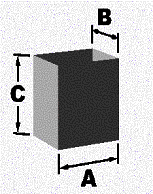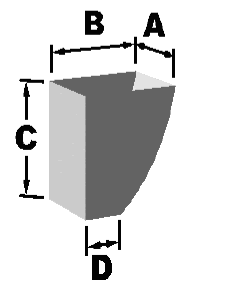There are lots of different ways to go about installing refrigeration on a boat, depending on budget and requirements. The weekend sailor needs to keep the beer cold and have cubes for the gin and tonics. The needs of the offshore cruiser may require a large freezer. One skipper I knew demanded freezer space for half a beef! A boat owner needs to consider power (engine driven, AC or DC), charging and pulldown cycles, size of freezer (if desired) and refrigeration boxes, use of evaporator plates or holdover plates, and type and thickness of insulation.
For offshore sailing it is best to go with well-insulated freezer or reefer boxes and holdover plates. The plates contain a glycol solution that freezes when the compressor runs and then absorbs heat for a long period time, extending the period before running the compressor again.
In Beatrix we have designated the companionway box as the freezer and the portside box as a refrigerator. We are using a 12 volt hermetic (sealed) compressor and holding plate system bought from Mark McBride of Miller and Miller Boatyard in Seattle. He is currently working on a new generation of his "Ice Sea" refrigeration system which utilizes a newly designed hermetic compressor just coming into production which is engineered for use in offshore yachts. This is same the "Masterflux" variable speed compressor user in the new Glacier Bay Micro HPS System. A number of Peterson Cutter Group members have bought the Micro HPS System in an initial release version but have not yet reported back as to its efficacy. Some have not yet been installed.
Note that at this time only Glacier Bay makes a true eutectic plate, and only for use with Glacier Bay compressors, which although they are are the best available, are usually of the price range of most small boat owners. All other plates use a glycol solution (anti-freeze) which approximates a true eutectic solution. Glacier Bay's is patented. The reason no alternative exists right now is that the solution needs to be non-toxic and non-corrosive, so it isn't a simple answer. Turns out there is a European formula for a true eutectic solution, but it isn't available in this country except by ordering in 55 gallon drums from Europe, which is prohibitive.. Mark is trying to get a license to make this stuff here in the USA. The advantage of this solution would be that our reefers and freezers would "hold" at a constant temperature set by the heat of crystallization of the eutectic solution until all the solution had changed phase from solid to liquid. The glycol solutions normally used are a "slush" and don't have flat curves as they warm up.
The KP44 refrigeration boxes appear to have different amounts of insulation. Without disassembling them it looks like the companionway box has less insulation than the port box. The heat loss in both boxes appears roughly identical, so either box would suffice as a reefer or freezer. In practice I think the 5" estimation is too high for the portside box. I intend to add Vacuum Panels from R-parts on the hull side to beef up the insulation. Vacuum panels are the best way to increase insulation as they can be added to the interior and have a very large R-value, but they need protection.. A good method to cover the vacuum panels is to use "poltruded fiberglass", also available from R-parts.
Short of spending thousands on Glacier Bay equipment, Mark's system is the best solution. It uses a single hermetic (sealed) compressor with solenoid valves and digital controls to supply cooling to the two holding plates in the freezer (companionway) and a single large holding plate in the refrigerator (portside box).
Insulating the floor is cheap and easy by using additional blue foam "bricks" that can be removed for cleaning or if more volume is needed.
In determining the size of the compressor and how long it needs to run I had to figure out the BTUs required in a 24 hour period. The tables below show BTUs required for using either box as a refrigerator or as a freezer. The data was derived theoretically from information provided by Glacier Bay on their website. The idea is to size the BTU capacity of the compressor and the number of holdover plates to the desired cycle time.
![]()
 |
A = 18” B = 19” C = 29” Internal Volume = 5.73 cu. ft. Original Insulation slightly less than 3” |
Insulation |
Refrigerator Output (BTU/24hr) |
Freezer Output (BTU/24hr) |
2” |
2947 |
5502 |
3” |
2358 |
4421 |
4” |
1965 |
3635 |
5” |
1768 |
3340 |
6” |
1572 |
3144 |
Ultra-R |
1375 |
2947 |
![]()
 |
A = 25” B = 30” C = 27” D = 12” Internal Volume = 8.9 cu. ft. Original Insulation = 5" (effectively less in practice) |
Insulation |
Refrigerator Output (BTU/24hr) |
Freezer Output (BTU/24hr) |
2” |
3949 |
7372 |
3” |
3159 |
5924 |
4” |
2633 |
4871 |
5” |
2369 |
4476 |
6” |
2106 |
4213 |
Ultra-R |
1843 |
394 |
![]()
Insulation |
R value |
Lifetime |
Cost |
Blue Foam |
R-5 |
? |
(Two inches of blue foam is R-10) |
Barrier-30 |
R-30 |
10 yrs |
$45/sq. ft. ($175/panel) |
R-Parts VIP |
R-28 |
15-25 yrs |
$24/sq. ft. with a $48/panel minimum. ($110/panel) |
Glacier Bay Ultra-R |
R-50 |
25 yrs |
$135 setup fee + $2.25/perimter inch ($216/panel + fee) |
![]()
Ice Sea Refrigeration
Mark McBride
Miller & Miller Boatyard
2700 Commodore Way
Building A2
Seattle, WA 98199
(206) 285-5958
(206) 285-3055 Fax
Last modified: March 23 2014 03:38